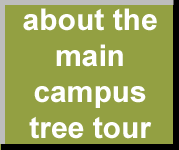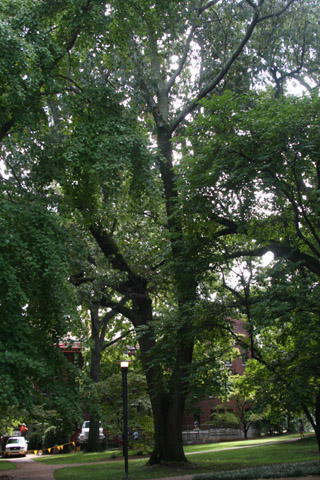 |  |  |  |
 |  |  |  |
An individual instance of Quercus velutina (black oak)

Permanent unique identifier for this particular organism:
http://bioimages.vanderbilt.edu/vanderbilt/7-313
Notes:
This large tree grows in the center of the lawn in front of Rand/Sarratt and is almost equidistant from Rand, Garland, and Old Central.
Black oak is another member of the red oak group and its leaves are similar to other members of the group. The lower sides of its leaves have variable hairiness, from tufts of blond hair where the veins come together to entirely covered with hair (the species name, velutina, comes from the term for velvety hair). The sinuses of the leaves tend to go deeper toward the midvein than the sinuses of northern red oak leaves. The best way to recognize this species is by observing its buds under a hand lens. They are entirely covered with blond hairs. The scales on the caps of the acorns are also covered with blond hairs.
Black oak can be found in a variety of habitats, but tends to be on drier sites than northern red oak. This particular tree has no branches near the ground but you may find twigs and leaves on the ground to examine. It is noteworthy in that it is described on p. 39 of The Trees of Vanderbilt. It is the only black oak on campus, but it is a large tree in its own right, having a diameter of 115 cm (45 in.).
Black oak is another member of the red oak group and its leaves are similar to other members of the group. The lower sides of its leaves have variable hairiness, from tufts of blond hair where the veins come together to entirely covered with hair (the species name, velutina, comes from the term for velvety hair). The sinuses of the leaves tend to go deeper toward the midvein than the sinuses of northern red oak leaves. The best way to recognize this species is by observing its buds under a hand lens. They are entirely covered with blond hairs. The scales on the caps of the acorns are also covered with blond hairs.
Black oak can be found in a variety of habitats, but tends to be on drier sites than northern red oak. This particular tree has no branches near the ground but you may find twigs and leaves on the ground to examine. It is noteworthy in that it is described on p. 39 of The Trees of Vanderbilt. It is the only black oak on campus, but it is a large tree in its own right, having a diameter of 115 cm (45 in.).
 |  |
Load database and switch to thumbnail view
Use this stable URL to link to this page:
http://bioimages.vanderbilt.edu/vanderbilt/7-313.htm
This organism is a living specimen that is part of the Vanderbilt University Arboretum with the local identifier 2-854.
This particular organism is believed to have managedmeans of establishment.
This organismal entity has the scope: multicellular organism.
Identifications:
Quercus velutina
Lam.
sec. fna.org 1993
common name: black oak
family: Fagaceae
Identified 2002-06-25 by Steven J. Baskauf
Location:
Vanderbilt University, Nashville, Davidson County, Tennessee, US
Click on these geocoordinates to load a map showing the location: 36.14655°, -86.80221°
Coordinate uncertainty about: 10 m.
Location of individual determined from GIS database.
Occurrences were recorded for this particular organism on the following dates:
2002-06-25
2002-06-14
2002-06-20
Remarks:Photographed in laboratory.
2002-09-27
2003-04-07
2013-12-11
2014-09-03
The following images document this particular organism.
Click on a thumbnail to view the image and its metadata.Load database and enable navigation by taxon and organism.































